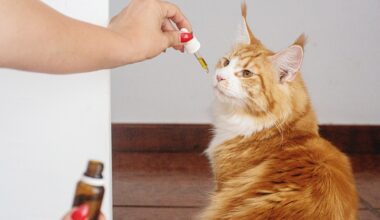How to Handle Accidents During Cat House Training
House training a cat can be a rewarding experience, yet accidents are inevitable in this process. First, it’s important to remain calm when an accident occurs. Yelling or punishing the cat will only increase fear and stress, making the problem worse. Instead, focus on prevention and redirecting behavior. Establish a consistent routine for feeding and litter box usage. This consistency helps your cat understand when and where they can go. Secondly, you need to keep an eye on your cat and observe behavior that indicates they need to go. Signs might include frequent sniffing around the house, crying, or heading to a corner. When you notice these signs, gently guide your cat to the litter box. After successful bathroom sessions, always reward your cat with treats or positive reinforcement to encourage good habits. If accidents happen, clean the area thoroughly with an enzyme-based cleaner to eliminate the scent of urine, which might attract your cat back to the same spot. By addressing accidents with patience, you can effectively train your cat, creating a happier home for everyone involved.
Another useful tip is to provide sufficient litter boxes. Ideally, you should have one litter box for each cat, plus an additional one. This helps ensure that your cat always has a place to go, minimizing accidents within the home. Choose boxes that are spacious, easy to access, and kept clean. Cats dislike dirty litter boxes, so scoop them regularly—several times a week is recommended. Additionally, experiment with different types of litter to see what your cat prefers; some cats have strong preferences. Avoid strong-scented litters that may deter your cat from using the box. If a cat chooses to eliminate outside the box, analyze what might be causing discomfort—this could be an issue with the box, the litter, or even health concerns. If you notice a sudden change in bathroom habits, consult a veterinarian to rule out health issues. It’s essential to provide a simple to clean and accessible area for your cat. Positive reinforcement strengthens the desirable behavior in your cat. Consistent protocols will help your cat become comfortable with the litter box over time.
Familiarizing your cat with the litter box from a young age is crucial. If your cat is a kitten, encourage exploration of the litter box. Place the kitten in the box after meals or naps; these are common times for bathroom needs. Providing various locations for litter boxes may also be beneficial. Give your cat options while still maintaining a clean environment. For adult cats, patience and understanding play vital roles in introducing them to a litter box, especially if they’ve been previously untrained. Make the litter box attractive and inviting; add fresh litter and ensure it isn’t too deep for the cat. Regularly changing the litter and cleaning the box help ensure comfort. If your cat still refuses to use the litter box, consider potential stressors. Stress can arise due to changes like moving, new pets, or litter box placement. Cats are sensitive creatures, and their habits can be influenced dramatically by their environment. Therefore, always provide consistent support and reassurance to develop a positive training atmosphere for both you and your cat.
Dealing with Behavioral Issues
Identifying behavioral issues can help address accidents during training. Fear, anxiety, or health problems can lead your cat to eliminate outside the litter area. Watch for signs of distress, such as hiding, aggression, or urination around the house. If you see these indications, re-evaluate the training process, and seek the help of a veterinarian if necessary. Ensure the litter box is in a quiet, accessible location—avoid busy areas that might spook your cat. Sometimes, it takes time for a cat to adjust to a new home or litter box. In case of repeated accidents, try to pinpoint triggers such as loud noises, changes in routine, or disagreements with other pets. Creating a calm, peaceful environment allows your cat to feel safe while using the litter box. You may need to consult with a pet behaviorist for effective strategies. Behavioral advice can help alleviate anxiety and reinforce desired behaviors. Additionally, medication might be necessary in some situations if anxiety persists. Thoroughly observing your cat’s behavior allows you to intervene early and lessen the impact of accidents.
Understanding a cat’s instincts can make house training much easier. Cats naturally prefer to bury their waste, which is why they look for loose soil or sand-like materials. Utilizing this instinct works to your advantage during training. If your cat eliminates outside the litter box, change the location or type of litter as needed. You can even try shallow boxes, as older cats may struggle with deep boxes. Moreover, incorporating natural instincts with environmental enhancements will benefit your cat’s overall experience. Adding scratch pads or toys near the litter box may create a positive association. Always supervise your cat after accidents to provide immediate guidance to the proper bathroom area. After guiding the cat back to the litter box following an accident, encourage it to eliminate inside the box by offering treats or praise. Be prepared to consistently address any accidents—this approach takes time and repetition. Alongside patience, maintain diligence in cleaning accidents thoroughly, diminishing the likelihood of a strong odor left for your cat to sense. With a supportive environment, together you can overcome hurdles and enjoy the journey toward successful house training.
In some instances, you may notice medical issues affecting your cat’s bathroom habits. Conditions such as urinary tract infections or bladder stones can lead to unexpected accidents. If you suspect any medical concerns, it’s best to consult a veterinarian promptly. They can diagnose problems and recommend appropriate treatment. Alongside medical causes, behavioral issues can stem from stress or territorial disputes with other pets in the house, leading a cat to avoid the litter box. Your goal is to provide an environment that reassures your cat. Setting up flavors and hiding spaces around the house will create a sense of comfort. After a successful elimination in the litter box, reinforce positively to continue encouraging this desired behavior. If accidents do occur, always clean adequately to remove the scent of urine and other indicators that may entice a return to the same spot. Gradual improvements can be made through understanding both your cat’s instincts and potential health issues. Through consistent training and a supportive atmosphere, your cat will thrive in its designated bathroom habits, ultimately leading to fewer accidents.
The Power of Positive Reinforcement
Utilizing positive reinforcement serves as an effective strategy during training. Always reward and celebrate your cat’s achievements to create lasting behaviors. Whenever your cat uses the litter box correctly, offer treats, loving attention, or gentle praise. This method establishes a connection between their actions and rewards, becoming a vital aspect of successful house training. Gradually, your cat will learn that using the litter box leads to positive experiences. Avoid using negative reinforcement; punishing your cat for accidents only creates fear and anxiety. Instead, focus on reinforcing good behavior through a consistent training regime. Over time, as your cat becomes familiar with the routine, they will establish a preference for using the litter box, resulting in fewer accidents. Consistency is crucial—always provide prompts to direct your cat toward the litter box, particularly after meals or naps. With patience and dedication, you will achieve a positive reinforcement cycle that nurtures your bond while effectively training your cat. Remember, the goal is to make the experience stress-free and enjoyable as possible for both of you.
Ultimately, house training takes time and patience, but with the right strategies and a positive mindset, you can successfully handle accidents as they arise. Be observant and attentive to your cat’s behaviors, needs, and environment to prevent issues before they arise. Keeping a clean and comfortable space for your cat is vital for its training success. Regularly evaluate and adjust your methods as required, and consult professionals when needed to guide you through the process. You’ll find that identifying triggers behind your cat’s behavior and providing solutions helps optimize the house training experience. With the understanding of how to navigate accidents and behavioral changes, you can confidently support your cat’s training journey and promote a happier and healthier household. The bond you develop along the way strengthens your relationship while creating a nurturing environment. Each success, after all, requires collective effort and understanding. Focus on building positive associations with the litter box and ensuring your cat’s well-being always remains a priority. Cats can adapt, provided caretakers are proactive, patient, and supportive throughout their training journey. Enjoy the experience and progress alongside your feline friend.


